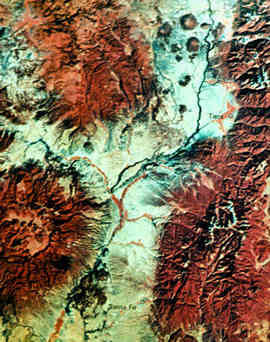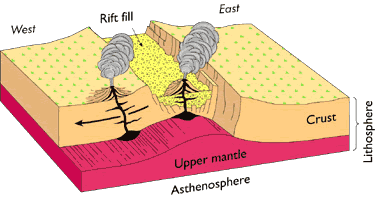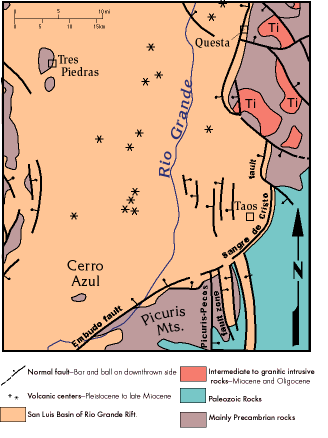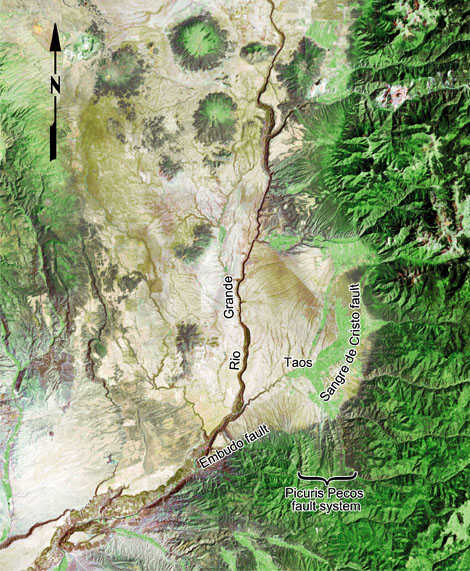|
||
|
|
 |
|
LANDSAT image of north-central New Mexico, vegetation in mountainous regions is red whereas the Rio Grande Rift stands out in light colors. |
Although from the human perspective, the Taos landscape appears tranquil, from a geologic perspective, Taos is located in one of the most dynamic and exciting geologic settings on the planet. Buried beneath the plateau is an enormous rent in Earth's rigid upper surface that is 20 miles across, and several miles deep. This rift, named the Rio Grande Rift (see photos and figures), continues to be active, as indicated by the occurrence of earthquakes and the presence of chambers of molten rock at depth. Evidence of past catastrophic seismic and igneous events is visible from most anywhere in the Taos area, including young fault scarps where the mountains join the plains, and the abundance of volcanoes and basalt flows on the plateau. Fortunately for the inhabitants, the faults usually release their built-up stress as frequent small, imperceptible tremors rather than as massive, destructive earthquakes, and the volcanoes have lain dormant for several million years.
The Rio Grande Rift has cleaved Northern Mexico, Texas, New Mexico, and half of Colorado over a distance of over 800 miles. The rift is somewhat like a plowed furrow with raised shoulders, partly filled with alluvium. In this area, the shoulders are the Sangre de Cristo Mountains on the east and the Brazos Uplift (Tusas Mountains) on the west. Just west of Taos, the floor of the rift is estimated to be down-faulted 36,000 feet. If we could vacuum out the alluvium, the basin would be six times deeper than the Grand Canyon.
 |
| A block diagram cartoon of the Rio Grande Rift shows how crustal extension localizes sedimentation and volcanism within and along the rift margins (click the image for a larger version). |
What caused the Rio Grande Rift? The Rio Grande itself did not cause the rift. Instead the river follows a topographic low within the rift. The generally accepted theory concerning its formation is that the rift is part of a global system of fractures in Earth's uppermost layers (the lithosphere) that form in order to accommodate relative movements of the rigid lithospheric plates. This global theory of plate interactions is called plate tectonics.
One excellent website for information on plate tectonics is maintained by the United States Geological Survey (USGS).
The lithosphere is broken into about a dozen major plates that move over an underlying layer of partially molten rocks (the asthenosphere). Most of the tectonic activity associated with plate tectonics occurs at or near plate margins. Where plates converge, huge mountain systems form (e.g. Alps, Himalayas), or arcuate curved chains of volcanoes develop (e.g. the Japanese and Aleutian Islands). Where plates move horizontally past one another, zones of startlingly energetic faults are present (e.g. the San Andreas fault system). Where oceanic plates diverge, juvenile crust is extruded on the ocean bottom in long, narrow, basaltic ridges (e.g., Iceland). Where continental plates diverge, rifts evolve.
 |
|
General geologic map of the Taos valley. Click on the map to see a shuttle photograph of the same area or click here for a pdf version of this map. |
The Taos area straddles the boundary between three geographic/geologic terrains and the faults that define their boundaries. The Sangre de Cristo Mountains and Picuris Mountains are split by the Picuris-Pecos fault system. The Sangre de Cristo Mountains and San Luis Basin are separated by the Sangre de Cristo fault zone, and the Picuris Mountains and the San Luis Basin are separated by the Embudo fault zone.
The Picuris-Pecos fault zone consists of a complex series of parallel north-striking, vertical to near-vertical faults that cut Precambrian through early Tertiary rocks in the Taos area. Presumably, the Picuris-Pecos fault extends northward into the basin, but is buried by the younger alluvium.
In our study area, the Embudo fault zone
is a complex system of left-oblique, north-down, strike-slip fault strands
that is over two kilometers wide. We have defined the terminus of the Embudo
fault at the Rio Grande del Rancho, where the dominantly strike-slip, east-striking
Embudo fault system swings northward and merges with the dominantly dip-slip
Sangre de Cristo fault. A variety of physical features help to define fault
scarps and photolineaments along the Embudo fault zone. These include springs
and deciduous trees such as willows and cottonwoods.
 |
| LANDSAT TM image of the Taos valley showing some of the principal structural and geographic elements. |
North of Taos, the mountains are bordered by the 160-km-long, north-striking, steeply west-dipping, normal Sangre de Cristo fault zone, the major rift-bounding structure of the San Luis Basin. Prominent fault scarps in Quaternary deposits exist along much of the fault zone. The southern section of the fault zone, between the Rio Grande del Rancho and the Rio Pueblo de Taos, is called the Cañon section of the Southern Sangre de Cristo fault (Machette et al., 1998). The Cañon section shows complex surface expressions and is interpreted as having ruptured during either Holocene or latest Pleistocene time. The Cañon fault represents the transition between the Embudo strike-slip fault zone and the Sangre de Cristo normal fault zone (Kelson et al., 1997).
The San Luis Basin is one of the major structural elements of
the Rio Grande rift. It is approximately 240 km long, and is bordered by the
Sangre de Cristo Mountains on the east, and the Tusas and San Juan Mountains
on the west. The southern part of the basin is a physiographically and geologically
unique terrain known as the Taos Plateau. The plateau is composed mostly of
3-5 million-year-old basalts that were erupted locally. The plateau surface
shows only minor dissection, although the Rio Grande and its tributaries are
confined to deep canyons cut through the volcanic rocks. The 800-ft-deep
Rio Grande gorge contains the best exposures of the volcanic rocks, as
well as the interlayered sands and gravels of the Chamita Formation that represent
westward-prograding alluvial fans of the Taos Range. The basalt flows pinch
out eastward and southward towards the edge of the basin.
The complex geologic setting makes the hydrogeology complex as well....
| Main |
comments/questions
to Paul Bauer
|